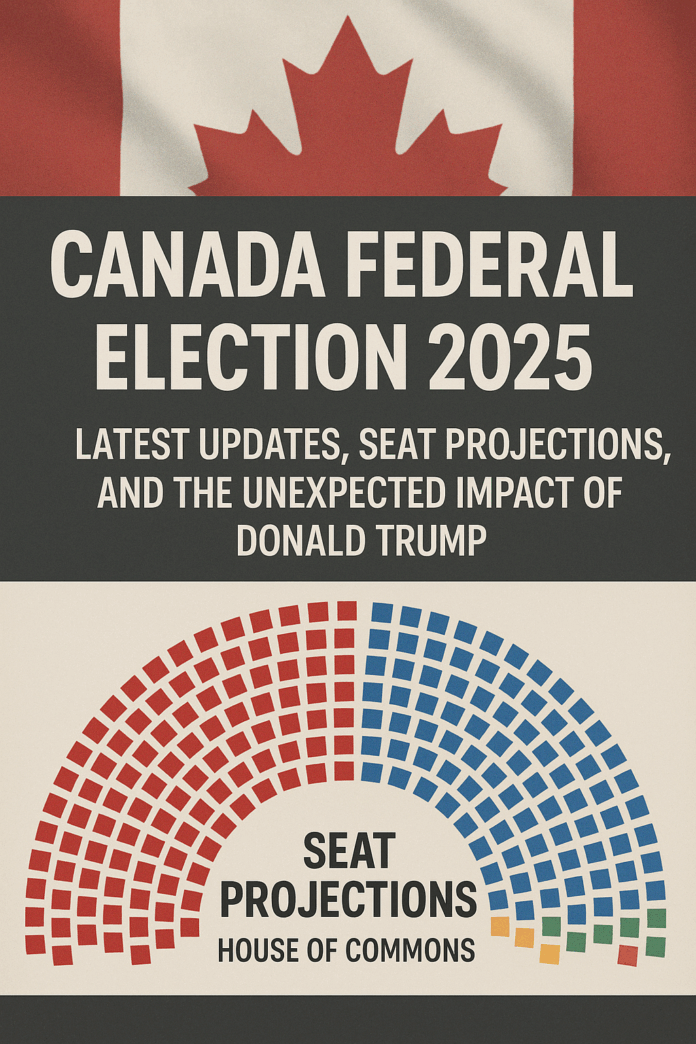
As Canadians head to the polls in one of the most consequential elections in recent history, the 2025 Federal Election is taking an unexpected turn — influenced not just by domestic issues, but also by political waves from the United States. Former U.S. President Donald Trump’s aggressive rhetoric has ignited a surge in Canadian nationalism, dramatically reshaping voter sentiment and shifting the momentum in favor of the Liberal Party.
Here’s a detailed analysis of the current landscape, predictions, and the surprising role Trump is playing in Canada’s election story.
📊 Current Seat Projections: Liberals Surge Ahead
Latest projections from major polling firms show a remarkable comeback for the Liberal Party, led by Mark Carney:
-
Liberal Party (Mark Carney): 162–204 seats (most likely 185)
-
Conservative Party (Pierre Poilievre): 130–150 seats
-
New Democratic Party (Jagmeet Singh): 30–35 seats
-
Bloc Québécois (Yves-François Blanchet): 25–30 seats
-
Green Party and Independents: Remaining seats
Considering the House of Commons has 343 seats, the magic number for a majority is 172. With current projections, the Liberals are poised to secure a clear majority, a dramatic reversal from earlier in the year when Conservatives seemed ahead.
Key Takeaway:
If these numbers hold, Mark Carney will become the next Prime Minister with a strong mandate, potentially altering Canada’s domestic and international agenda.
🇺🇸 Donald Trump’s Unexpected Influence on Canadian Politics
Donald Trump’s recent actions — including proposing new tariffs on Canadian imports and controversial remarks suggesting Canada should consider joining the U.S. — have triggered a patriotic backlash across Canada.
Impact on the 2025 Election:
-
Rise of Nationalism: Canadians across party lines are rallying around the idea of defending national sovereignty.
-
Shift in Voter Priorities: Topics like healthcare and housing, while still important, have been overshadowed by concerns about Canadian independence and foreign policy.
-
Boost for Liberals: The Liberal Party has successfully framed the election as a defense of Canadian autonomy, attracting centrist voters who might have leaned Conservative earlier.
Mark Carney’s campaign has aggressively positioned him as the leader who can “stand up to U.S. pressure,” while Pierre Poilievre has struggled to fully distance himself from right-wing populist movements that some voters associate with Trump.
🗳️ Voter Sentiment: Sovereignty First, Economy Second
According to advance polling data:
-
Over 7.3 million Canadians have already cast their votes — a historic turnout for early voting.
-
Surveys show that national pride and resistance to U.S. influence are now among the top three concerns for voters, alongside cost-of-living and healthcare access.
-
Younger voters (ages 18-34) show strong preference for leaders who emphasize environmental protection, economic resilience, and sovereignty — giving a slight edge to Liberals and the NDP.
🔮 2025 Election Predictions: What’s Next?
If the momentum continues:
-
Mark Carney is likely to secure a comfortable majority, allowing him to pursue a more independent foreign policy stance.
-
Pierre Poilievre’s Conservatives may regroup after a disappointing performance, potentially leading to leadership challenges within the party.
-
The NDP could remain a minor but influential player, especially if Liberals fall short of a majority.
The results will redefine Canada’s relationship with the U.S., strengthen national institutions, and possibly trigger major reforms in trade, defense, and immigration policies.
✨ Conclusion: A Defining Moment for Canada
The 2025 Federal Election is shaping up to be not just a vote on internal issues, but a powerful statement about Canada’s identity on the global stage. With Trump’s shadow looming large, Canadians are signaling that they are ready to chart their own course, firmly and proudly.
As final results roll in tonight, all eyes are on Mark Carney and whether his message of stability and sovereignty will carry him — and Canada — into a new political era.


